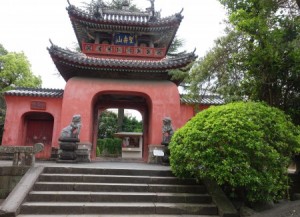
The Sofukuji Temple is a highlighted building on the Welcome to Nagasaki map. It was built a few years after the Kofukuji Temple. Like its predecessor, it was used by Chinese immigrants who lived in Nagasaki. It was founded by the Obaku Zen Sect. This national landmark has become a famous symbol of Chinese architecture in Nagasaki.
After visiting some of the other Chinese temples in Nagasaki, we wandered around looking for Sofukuji.
To enter the compound, we had to walk up several steps that led to a magnificent red archway that is called Ryugumon. After paying an admission fee, we were handed a tiny pamphlet in Japanese. The clerk could not speak English. English materials were not visible. We turned and spotted a few flights of stairs.
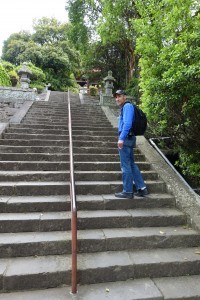
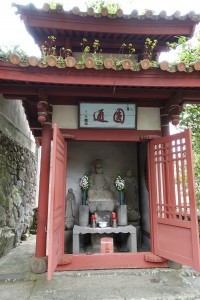
As Ira pranced up, I took a short break.
At one point, I passed this small shrine.
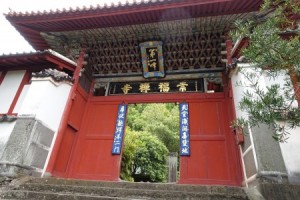
We eventually reached the Sofukuji Inner Gate. The complex jointing under the eaves follows the 17th century southern Chinese architectural style. It is the only one of its kind in Japan. There is an engraved framed tablet in the center with calligraphy by the Zen priest, Sokuhi.

As we walked through this entryway, we saw an ornate red structure.
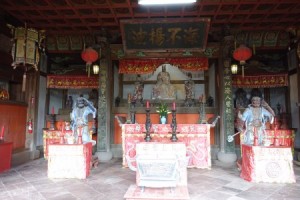
When we got closer, we could see many ceremonial objects inside.
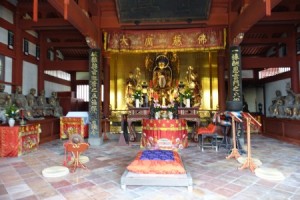
Inside the Main Hall were statues of Sakyamuni Buddha and his two disciples Mahakasyapa and Ananda. On the left and right hand sides were statues of 18 arhats. According to a sign, all of the Buddhist iconology artifacts inside this hall are from the Ming Dynasty (1368-1661).
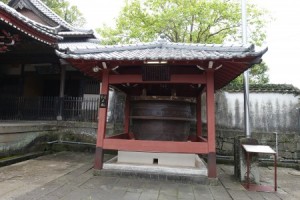
This Sofukuji Temple Bell was forged in 1647 by Ayama Kunihisa, the 1st generation of a famous family of blacksmiths.
The Inner Gate, Daiippomon, and the main Buddha Hall, Daiohoden, were both constructed in Ningbo, China. Then shipped to Nagasaki and reassembled on the current site. Both are considered national treasures.

As we retraced our steps back to the main entrance, we gained a different perspective. This gem was tucked neatly into the surrounding urban landscape. Little can be seen or appreciated from street level. Unless you make the effort to climb, you will miss out on this piece of Chinese history in Japan. I was thrilled to find this Chinese treasure in the heart of Nagasaki.
Related Posts
Precruise Exploration of Hong Kong
Fo Guang Shan Buddha Memorial Center
Sandra’s Bio
Sandra Bornstein is the author of MAY THIS BE THE BEST YEAR OF YOUR LIFE. It is available on Amazon. Sandra’s memoir highlights her living and teaching adventure in Bangalore, India. She is a licensed Colorado teacher who has taught K-12 students in the United States and abroad as well as college level courses. Sandra is married and has four adult sons. The memoir was a finalist in the Travel category for the 2013 Next Generation Indie Book Awards, the 2013 International Book Awards, the 2013 National Indie Book Excellence Awards, the 2013 USA Best Book Awards, and received an Honorable Mention award in the Multicultural Non-Fiction category for the 2013 Global ebook Awards.
Leave a Reply
You must be logged in to post a comment.